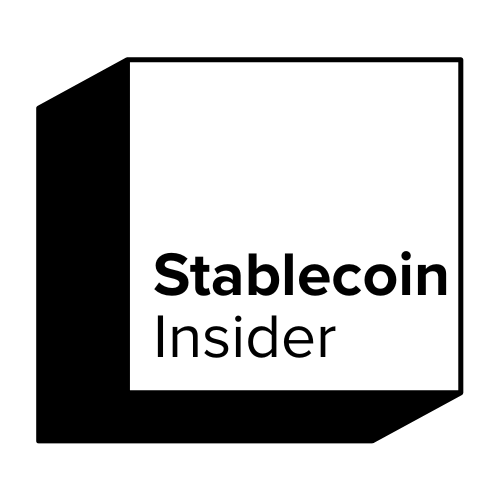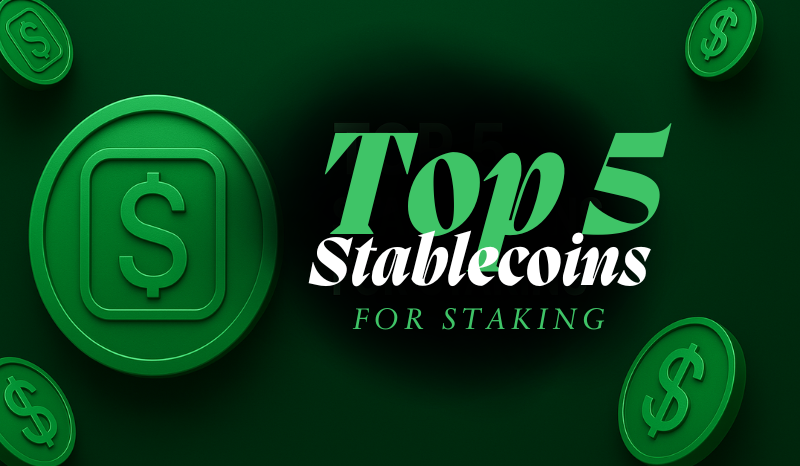Staking has evolved from a mechanism exclusive to proof-of-stake (PoS) blockchains into a broader financial strategy, including the use of stablecoins.
In 2025, staking stablecoins is becoming increasingly popular as it offers users a low-volatility way to earn passive income while maintaining exposure to dollar-pegged digital assets.
Unlike traditional staking of volatile assets like ETH or SOL, staking stablecoins reduces price risk while still offering attractive yields—especially when leveraged through DeFi protocols, CeFi platforms, or real-world asset-backed projects.
Key Takeaways:
- Staking stablecoins provides a relatively safe yield without the volatility of crypto tokens.
- Not all stablecoins are equal—yields, risks, and use cases vary by asset and platform.
- This list explores the top 5 stablecoins for staking in 2025 based on security, yield potential, platform integrations, and use cases.
What is Stablecoin Staking?
Stablecoin staking refers to locking or lending stablecoins in a smart contract or platform in exchange for yield. These yields are typically generated from lending, liquidity provision, or revenue-sharing models. Common staking venues include:
- DeFi protocols like Aave, Compound, Curve, or Morpho
- CeFi platforms such as Binance Earn, Coinbase, Nexo, and Kraken
- Real-world asset protocols (RWAs) like Ondo Finance or Mountain Protocol
- Liquid staking for stablecoins, such as sDAI
Staking stablecoins offers an excellent entry point into crypto-native yield strategies for users who prioritize capital preservation.
Criteria for Choosing Stablecoins for Staking
Before staking stablecoins, consider the following factors:
- Peg Stability: The coin must maintain a 1:1 value with fiat (typically USD).
- Security & Collateralization: Fully backed by fiat, overcollateralized, or algorithmic?
- APY Potential: Varies across platforms but reflects risk levels and source of yield.
- Protocol Support: The more platforms support a stablecoin, the more options for staking.
- Regulatory Resilience: Legal clarity and protection from regulatory delistings.
- Chain Availability: Supported on Ethereum, Solana, Polygon, Arbitrum, etc.
Top 5 Stablecoins for Staking in 2025
1. USDC (USD Coin)
- Issuer: Circle
- Backing: Fully backed by cash and short-term U.S. Treasuries, with monthly attestations
- Best Platforms: Aave, Compound, Coinbase Earn, Stripe Yield
- APY Range: 3%–7%
- Pros:
- Regulatory compliance and transparency
- High integration across DeFi and CeFi platforms
- Excellent liquidity across multiple chains
- Cons:
- Centralized issuer (Circle)
- Potential exposure to U.S. banking system risks
- Best Use Case: Institutional-grade yield generation and conservative DeFi lending
2. USDT (Tether)
- Issuer: Tether Limited
- Backing: Portfolio of short-term securities and other reserves (improved transparency in 2024–2025)
- Best Platforms: Binance Earn, Tron staking pools, Bitfinex lending, Bybit
- APY Range: 5%–10%
- Pros:
- Most widely adopted stablecoin globally
- High volume and liquidity
- Supported on nearly every blockchain
- Cons:
- Longstanding concerns over reserve transparency
- Centralized governance
- Best Use Case: High-yield opportunities on centralized exchanges and non-U.S. platforms
3. DAI
- Issuer: MakerDAO (decentralized)
- Backing: Overcollateralized with ETH, USDC, and real-world assets (e.g., short-term treasuries)
- Best Platforms: Maker DSR (via Spark), Morpho Blue, Yearn Vaults
- APY Range: 4%–8% via Dynamic Savings Rate (DSR)
- Pros:
- Fully decentralized and censorship-resistant
- Transparent collateral system
- Resilient during market crashes
- Cons:
- Partial reliance on centralized assets (USDC)
- Requires some technical familiarity to use advanced tools
- Best Use Case: DeFi-native staking and long-term savings
4. sDAI (Staked DAI)
- Issuer: MakerDAO / Spark Protocol
- Backing: Automatically earns DSR yield while maintaining liquidity
- Best Platforms: Spark, DeFi vaults, integrated DeFi protocols
- APY Range: 6%–8%
- Pros:
- Set-it-and-forget-it yield; no manual reinvestment
- Earns interest while being used in DeFi
- Liquid—can be swapped or bridged easily
- Cons:
- Limited platform support compared to DAI
- May be misunderstood as a different asset than DAI
- Best Use Case: Passive income and composable DeFi strategies
5. GHO
- Issuer: Aave DAO
- Backing: Overcollateralized with crypto assets, governed by Aave community
- Best Platforms: Aave V3, GHO staking vaults
- APY Range: 4%–9%
- Pros:
- Fully integrated with Aave lending protocol
- Decentralized issuance and governance
- Incentives available for early adopters
- Cons:
- Relatively new; less market penetration
- Limited to Aave ecosystem
- Best Use Case: Yield generation within Aave for users already engaged in lending/borrowing
Bonus Mentions
EUROC
- Euro-backed version of USDC, issued by Circle
- Use Case: For European users or EUR-denominated yield opportunities
USDY / TBY (Ondo / Backed)
- Real-world asset-backed stablecoins backed by U.S. treasuries
- Use Case: Tokenized treasury yields for yield-hungry investors
crvUSD
- Issuer: Curve Finance
- Backing: Soft-pegged algorithmic stablecoin using LLAMMA AMM model
- Use Case: High-yield DeFi strategies within Curve ecosystem
Where to Stake These Stablecoins
- DeFi Platforms: Aave, Spark Protocol, Compound, Curve, Morpho, Yearn
- CeFi Platforms: Binance, Nexo, Coinbase, Kraken
- New Protocols:
- Ondo Finance: Tokenized treasuries (USDY)
- Mountain Protocol: Yield-bearing, regulated stablecoins (USDM)
- Ethena: Synthetic yield-bearing stablecoins (USDe)
Risks of Stablecoin Staking
While stablecoin staking reduces price volatility, it is not risk-free:
- Smart Contract Risk: Bugs in DeFi protocols may lead to loss of funds.
- Depegging Events: Collateral shocks or liquidity drains can cause temporary or permanent loss of peg.
- Platform Insolvency: Centralized platforms may face insolvency or regulatory shutdown.
- Regulatory Action: Sudden enforcement actions can freeze assets or limit functionality.
- Liquidity Constraints: DeFi protocols may impose withdrawal slippage during high volatility.
Conclusion
Staking stablecoins in 2025 is more accessible and profitable than ever. Whether you’re seeking regulated yields with USDC or decentralized, DeFi-native income through sDAI or GHO, there’s a wide range of opportunities to suit every risk profile.
As new protocols emerge and real-world assets enter the crypto ecosystem, expect staking yields and innovation to grow. Choose your stablecoin wisely, diversify across platforms, and always perform your own due diligence.
Read Next:
FAQ: Staking Stablecoins
Is staking stablecoins safe?
Staking stablecoins is generally safer than volatile crypto assets but still carries risks like smart contract bugs, platform hacks, and depegging.
What’s the best APY I can earn from staking stablecoins?
APYs vary. In 2025, expect ranges between 3% and 10% depending on the asset and platform.
Can I stake stablecoins on centralized platforms?
Yes—platforms like Binance, Coinbase, Nexo, and Kraken offer stablecoin earn or staking programs.
Do I still earn rewards during market downturns?
Yes. Since staking rewards are often from lending or RWA yields, they’re not tied to market volatility.
What is sDAI vs DAI?
sDAI is a yield-bearing version of DAI that automatically earns the MakerDAO savings rate. It simplifies passive income while keeping liquidity intact.

